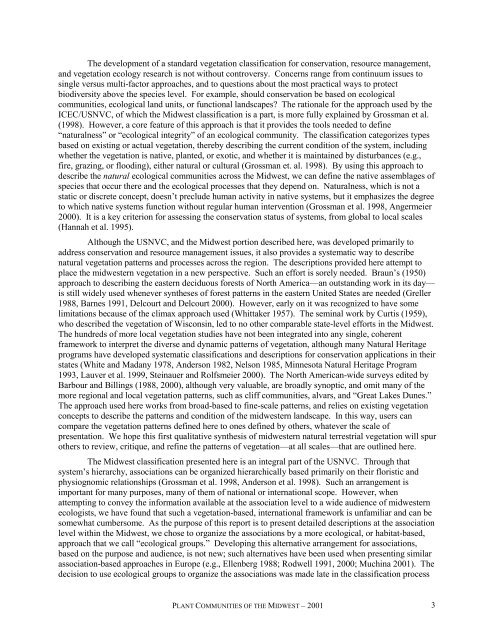Plant Communities of the Midwest - NatureServe
Plant Communities of the Midwest - NatureServe
Plant Communities of the Midwest - NatureServe
Create successful ePaper yourself
Turn your PDF publications into a flip-book with our unique Google optimized e-Paper software.
The development <strong>of</strong> a standard vegetation classification for conservation, resource management,<br />
and vegetation ecology research is not without controversy. Concerns range from continuum issues to<br />
single versus multi-factor approaches, and to questions about <strong>the</strong> most practical ways to protect<br />
biodiversity above <strong>the</strong> species level. For example, should conservation be based on ecological<br />
communities, ecological land units, or functional landscapes The rationale for <strong>the</strong> approach used by <strong>the</strong><br />
ICEC/USNVC, <strong>of</strong> which <strong>the</strong> <strong>Midwest</strong> classification is a part, is more fully explained by Grossman et al.<br />
(1998). However, a core feature <strong>of</strong> this approach is that it provides <strong>the</strong> tools needed to define<br />
“naturalness” or “ecological integrity” <strong>of</strong> an ecological community. The classification categorizes types<br />
based on existing or actual vegetation, <strong>the</strong>reby describing <strong>the</strong> current condition <strong>of</strong> <strong>the</strong> system, including<br />
whe<strong>the</strong>r <strong>the</strong> vegetation is native, planted, or exotic, and whe<strong>the</strong>r it is maintained by disturbances (e.g.,<br />
fire, grazing, or flooding), ei<strong>the</strong>r natural or cultural (Grossman et. al. 1998). By using this approach to<br />
describe <strong>the</strong> natural ecological communities across <strong>the</strong> <strong>Midwest</strong>, we can define <strong>the</strong> native assemblages <strong>of</strong><br />
species that occur <strong>the</strong>re and <strong>the</strong> ecological processes that <strong>the</strong>y depend on. Naturalness, which is not a<br />
static or discrete concept, doesn’t preclude human activity in native systems, but it emphasizes <strong>the</strong> degree<br />
to which native systems function without regular human intervention (Grossman et al. 1998, Angermeier<br />
2000). It is a key criterion for assessing <strong>the</strong> conservation status <strong>of</strong> systems, from global to local scales<br />
(Hannah et al. 1995).<br />
Although <strong>the</strong> USNVC, and <strong>the</strong> <strong>Midwest</strong> portion described here, was developed primarily to<br />
address conservation and resource management issues, it also provides a systematic way to describe<br />
natural vegetation patterns and processes across <strong>the</strong> region. The descriptions provided here attempt to<br />
place <strong>the</strong> midwestern vegetation in a new perspective. Such an effort is sorely needed. Braun’s (1950)<br />
approach to describing <strong>the</strong> eastern deciduous forests <strong>of</strong> North America—an outstanding work in its day—<br />
is still widely used whenever syn<strong>the</strong>ses <strong>of</strong> forest patterns in <strong>the</strong> eastern United States are needed (Greller<br />
1988, Barnes 1991, Delcourt and Delcourt 2000). However, early on it was recognized to have some<br />
limitations because <strong>of</strong> <strong>the</strong> climax approach used (Whittaker 1957). The seminal work by Curtis (1959),<br />
who described <strong>the</strong> vegetation <strong>of</strong> Wisconsin, led to no o<strong>the</strong>r comparable state-level efforts in <strong>the</strong> <strong>Midwest</strong>.<br />
The hundreds <strong>of</strong> more local vegetation studies have not been integrated into any single, coherent<br />
framework to interpret <strong>the</strong> diverse and dynamic patterns <strong>of</strong> vegetation, although many Natural Heritage<br />
programs have developed systematic classifications and descriptions for conservation applications in <strong>the</strong>ir<br />
states (White and Madany 1978, Anderson 1982, Nelson 1985, Minnesota Natural Heritage Program<br />
1993, Lauver et al. 1999, Steinauer and Rolfsmeier 2000). The North American-wide surveys edited by<br />
Barbour and Billings (1988, 2000), although very valuable, are broadly synoptic, and omit many <strong>of</strong> <strong>the</strong><br />
more regional and local vegetation patterns, such as cliff communities, alvars, and “Great Lakes Dunes.”<br />
The approach used here works from broad-based to fine-scale patterns, and relies on existing vegetation<br />
concepts to describe <strong>the</strong> patterns and condition <strong>of</strong> <strong>the</strong> midwestern landscape. In this way, users can<br />
compare <strong>the</strong> vegetation patterns defined here to ones defined by o<strong>the</strong>rs, whatever <strong>the</strong> scale <strong>of</strong><br />
presentation. We hope this first qualitative syn<strong>the</strong>sis <strong>of</strong> midwestern natural terrestrial vegetation will spur<br />
o<strong>the</strong>rs to review, critique, and refine <strong>the</strong> patterns <strong>of</strong> vegetation—at all scales—that are outlined here.<br />
The <strong>Midwest</strong> classification presented here is an integral part <strong>of</strong> <strong>the</strong> USNVC. Through that<br />
system’s hierarchy, associations can be organized hierarchically based primarily on <strong>the</strong>ir floristic and<br />
physiognomic relationships (Grossman et al. 1998, Anderson et al. 1998). Such an arrangement is<br />
important for many purposes, many <strong>of</strong> <strong>the</strong>m <strong>of</strong> national or international scope. However, when<br />
attempting to convey <strong>the</strong> information available at <strong>the</strong> association level to a wide audience <strong>of</strong> midwestern<br />
ecologists, we have found that such a vegetation-based, international framework is unfamiliar and can be<br />
somewhat cumbersome. As <strong>the</strong> purpose <strong>of</strong> this report is to present detailed descriptions at <strong>the</strong> association<br />
level within <strong>the</strong> <strong>Midwest</strong>, we chose to organize <strong>the</strong> associations by a more ecological, or habitat-based,<br />
approach that we call “ecological groups.” Developing this alternative arrangement for associations,<br />
based on <strong>the</strong> purpose and audience, is not new; such alternatives have been used when presenting similar<br />
association-based approaches in Europe (e.g., Ellenberg 1988; Rodwell 1991, 2000; Muchina 2001). The<br />
decision to use ecological groups to organize <strong>the</strong> associations was made late in <strong>the</strong> classification process<br />
PLANT COMMUNITIES OF THE MIDWEST – 2001<br />
3
















